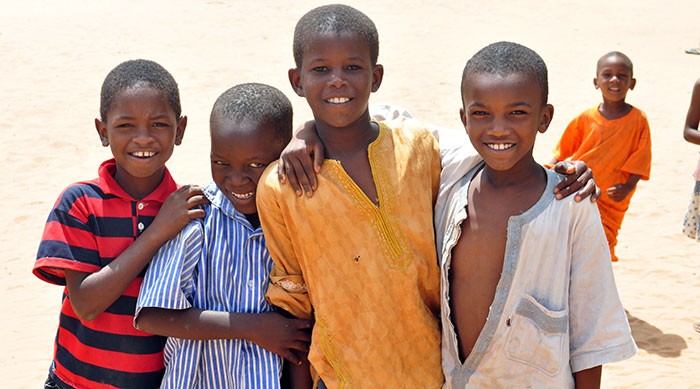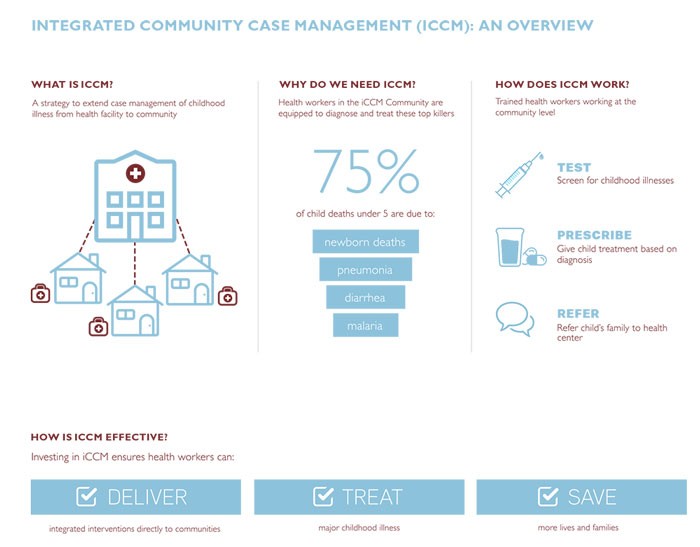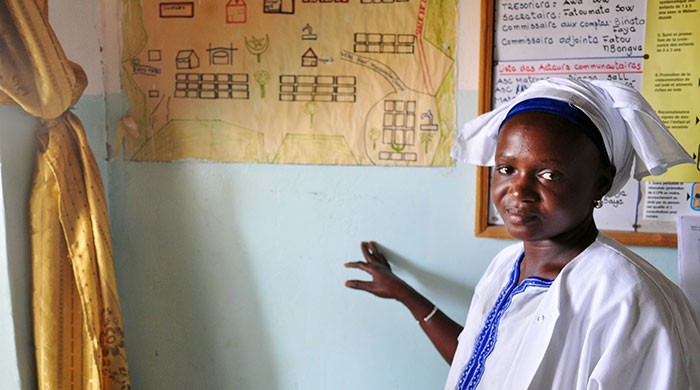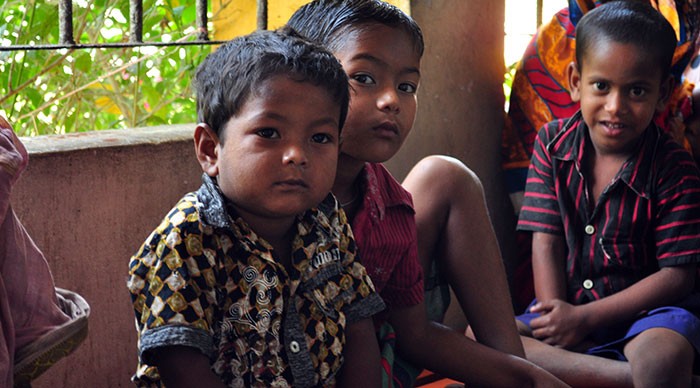- What We Do
- Agriculture and Food Security
- Democracy, Human Rights and Governance
- Economic Growth and Trade
- Education
- Ending Extreme Poverty
- Environment and Global Climate Change
- Gender Equality and Women's Empowerment
- Global Health
- Water and Sanitation
- Working in Crises and Conflict
- U.S. Global Development Lab

Pneumonia, diarrhea, and malaria account for the vast majority of deaths among children under 5 years of age. These three illnesses, taken together with newborn deaths, are responsible for 75 percent of the under-5 mortality rate. Under-5 deaths have fallen from an annual 12.7 million in 1990 to 5.9 million in 2015 – a dramatic decrease, but one that demands further progress.
The Challenges of Accessibility
Many child deaths attributed to pneumonia, diarrhea, and malaria could be averted by appropriate use of known, affordable, low-technology interventions, including antibiotics, oral rehydration solution, and zinc treatment for diarrheal diseases, and anti-malarials. However, in many high-mortality countries, families and caregivers lack access to high-quality facility-based services. Reliable and timely access to treatment is fundamental to successfully addressing child mortality.
In many regions worldwide, a majority of caregivers seeking care for childhood illness turn to the private sector – ranging from nearly 80 percent in South Asia to just over 50 percent in sub-Saharan Africa. Engaging and strengthening the private health sector thus provides a vital approach to improving the quality and accessibility of care. In the absence of private facility-based services, integrated community case management (iCCM) provides a platform from which trained community health workers (CHWs) can diagnose and treat key illnesses, as well as identify and refer those cases in need of immediate facility services. These models can be adapted to meet the specific context and needs of a country or community and provide a means of identifying and treating other threats to child health, such as neonatal infections and child malnutrition.
USAID’S Response
Worldwide, the lives of 100 million children have been saved since 1990, due in part to the work of the U.S. Agency for International Development (USAID). USAID’s child health efforts encompass a range of interventions across the continuum of care. With malaria, pneumonia, diarrhea, and neonatal mortality accounting for a combined 75 percent of child deaths worldwide, USAID interventions focus on timely, accurate diagnosis and treatment of malaria; water, sanitation and hygiene (WASH) infrastructure and behaviors; adequate nutrition; and strong, resilient routine immunization systems.
Malaria. The President’s Malaria Initiative (PMI), led by USAID and implemented together with the Centers for Disease Control (CDC), works with national malaria programs to reach pregnant women and children under the age of 5 – those most susceptible to malaria – and delivers equitable prevention and care. The initiative emphasizes community-based treatment, thus building local capacity and strengthening local health systems. In Africa, all-cause mortality rates among children under 5 have declined significantly in 16 out of 19 countries covered under the President’s Malaria Initiative, ranging from 18 percent to 67 percent.
Water, sanitation and hygiene. Access to improved WASH services benefits entire communities and saves children’s lives. Since fiscal year 2014, USAID’s water activities have resulted in more than 4.3 million people with improved access to sanitation facilities. WASH infrastructure and behaviors are closely linked to nutrition, and last year USAID’s nutrition efforts reached more than 12 million children with programs that reduced stunting and anemia increased use of optimal nutrition practices, supported community gardens, and treated acute malnutrition.
Private sector engagement. USAID leverages the support of the private sector throughout many of its child health programs and initiatives and works to actively build the capacity of the private sector to provide high-quality health information, products, and services. USAID’s Strengthening Health Outcomes through the Private Sector (SHOPS) project and its predecessor, Point of Use Water Disinfection and Zinc Treatment (POUZN) project, have worked to strengthen diarrhea case management in priority USAID countries for the past decade. The current project plays a leadership role in guiding ministries of health in developing public-private partnerships, implementing evidence-based private sector programs, and improving the quality of services offered by private providers of maternal and child health services.
Integrated community case management. USAID additionally works to combat global child mortality through both direct and indirect support of iCCM programs. USAID’s work surrounding iCCM includes supporting implementation of iCCM programs at the community level, strengthening coordination of iCCM programs at the national level, advocating for integrated case management at the national and global levels, and synthesizing research findings and the latest learning from iCCM programming worldwide.


Community health workers. USAID supports programs to train, supply, and supervise front-line health workers to treat children for both diarrhea and pneumonia, as well as malaria in malaria-affected countries. These health workers employ affordable and low-technology interventions, including oral rehydration solution and zinc, oral antibiotics, and artemisinin-based combination therapy. Rapid diagnostic tests for malaria enable CHWs to test for malaria at the community level and to differentiate between malarial and non-malarial fevers in children. By empowering community health workers and bringing the point of care into communities, community-level interventions encourage families to seek out needed care.
Strong health systems. Fundamental to the structure of iCCM programs are close linkages with the country’s or broader community’s health system. To further support the success of iCCM programs, USAID works to develop and strengthen systems of monitoring and evaluation, supply chain systems, clinical referral networks, and supportive supervision from health facility staff to CHWs. In this way, iCCM programs are able to operate within the nexus of a strong and supportive health system. USAID is also a Steering Committee member of the iCCM Task Force, a collaboration of organizations working to support countries to strengthen their iCCM programs against a core set of iCCM benchmarks.

Examples of our Work
By empowering community health workers and bringing the point of care into communities, iCCM programs encourage families to seek out care – especially in the first 24 hours of illness onset, a crucial timeframe for successful treatment. Following the implementation of an iCCM program in Ghana, 92 percent of caregivers of sick children sought treatment from CHWs trained to manage pneumonia and malaria; 77 percent of those caregivers sought care within 24 hours of illness onset. In Zambia, an iCCM program resulted in 68 percent of children with pneumonia receiving early and appropriate care from CHWs, and a significant decline in overtreatment of malaria.
USAID is currently working in India, Ghana, Kenya, Nigeria, and Uganda to promote zinc and oral rehydration salts (ORS) for the treatment of childhood diarrhea, capable of averting 20 percent of child deaths worldwide. With an emphasis on private sector channels, USAID is working with local manufacturers to expand access to low-cost, quality zinc and ORS in urban, peri-urban, and rural settings. USAID is also working to increase demand for both branded and generic commodities and is training care providers and pharmacists in new treatment protocols.
Through the President’s Malaria Initiative, USAID emphasizes community-based treatment of malaria, with community health workers and household and community leaders working together to detect, diagnose, and treat the illness. In Tanzania, where 70,000 people die from malaria each year, USAID efforts have reached millions: in less than a decade, more than 4 million insecticide-treated bed nets have been distributed, and 31 million treatments have been administered. Community health workers use mobile phones, tablets, and rapid diagnostic tests during household visits, testing and treating individuals as necessary. Child mortality has fallen by 28 percent, and the prevalence of malaria in Zanzibar, off Tanzania’s eastern coast, fell from 25 percent in 2005 to less than 1 percent today.
Photo Gallery

Preventing Child and Maternal Deaths
How will USAID work with partners to save 15 million children by 2020 in our 25 priority countries? Photo credit: Amy Fowler/USAID.

225 Million Women around the World Have an Unmet Need for Family Planning.
Allowing families to have children at the healthiest time for the child and mother is one of the best interventions to end preventable child and maternal deaths. Healthy timing and spacing of pregnancies could save 5 million children by 2020. Photo credit: USAID.

Prevention & Treatment of Childhood Illness
Illnesses like pneumonia and diarrhea are among the largest killers of children under 5. Appropriately diagnosing and treating childhood illnesses can save 1.3 million children's lives by 2020. Photo credit: JSI/Nepal Family Health Initiative.

Malaria
Preventing and treating malaria through the President's Malaria Initiative could save 700,000 children. Photo credit: Jane Silcock/USAID.

Quality and Respectful Care during Delivery
Women around the world give birth on dirt floors with little or no access to quality care. By increasing quality care around birth and delivery and ensuring women give birth in the presence of a skilled birth attendant, we can save 3 million children. Photo credit: Amy Fowler/USAID.

Undernutrition Robs Children of Their Potential
Undernutrition contributes to nearly half of under-5 deaths. Better maternal and child nutrition, particularly in the 1,000 days from conception to the child's 2nd birthday, could save 1 million children by 2020. Photo credit: Amy Fowler/USAID.

Importance of Clean Water and Better Hygiene
Families and health workers may not know the benefits of handwashing before preparing food or interacting with a patient. Better hygiene and clean water could save 1 million children's lives. Photo credit: Amy Fowler/USAID.

Strengthening Routine Immunization
In 2015, the U.S. Government pledged $1 billion to Gavi, the Vaccine Alliance. By working to strengthen routine immunizations and working with Gavi to ensure the right vaccines are available and affordable, we can save 2 million children. Photo credit: Neil Brandvold for USAID.

Impact of Other Development Efforts
Other development efforts, including investments by the U.S. President's Emergency Plan for AIDS Relief (PEPFAR), will save an additional 1 million lives. Photo credit: Jane Silcock/USAID.

2015 Acting on the Call Report
USAID is working with partners to scale up what works to save children, and we're reporting back annually on progress. Check out the 2015 Acting on the Call report for more information.
Resources
USAID 2015 Acting on the Call: Ending Preventable Child and Maternal Deaths
USAID FY 2014 Annual Health Programs Annual Report to Congress
Photo Gallery: USAID’s Efforts to End Preventable Child Deaths
President’s Malaria Initiative
UNICEF Committing to Child Survival: A Promise Renewed 2015 Progress Report







Comment
Make a general inquiry or suggest an improvement.